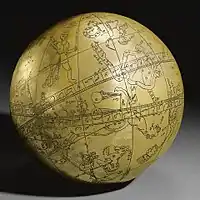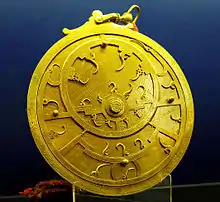Orta Çağ İslam dünyasında astronomi
İslam astronomi, özellikle İslam'ın Altın Çağında (8 ve 15. yüzyıl) sırasında,[1] İslam dünyasında yapılan astronomik gelişmeleri içerir ve çoğunlukla Arapça yazılmıştır. Bu gelişmeler özellikle Uzak Doğu ve Hindistan'da daha sonra Orta Doğu, Orta Asya, Endülüs ve Kuzey Afrika'da gerçekleşti. İslam Astronomisinin Bizans[2][2][2][2][3] ve Avrupa[3][3][3][3][4] astronomisi üzerinde önemli bir etkisi olmasının yanı sıra, Çin ve Mali astronomisini de büyük ölçüde etkilemiştir.[4][5][6]
Aldebaran, Altair, ve Deneb gibi gökyüzündeki yıldızların önemli bir kısmı ve Alidade, Azimuth ve Nadir gibi astronomik terimler hala Arapça kelimeler[7][7][7][7][8][8] ile isimlendirilmektedir. Bugün hala literatürün büyük bir kısmı İslami astronomi'den gelmektedir, dünya çapında Astronomiyle ilgili 10.000'den fazla İslami el yazması vardır, fakat bunların çoğu okunmayan ya da kataloğunu hazırlanmayan kayıtlardır. Yine de astronomi alanının içindeki İslami aktivite oldukça doğru bir şekilde betimlenebilir.[9]

Notlar ve Kaynakça
Notlar
Alıntılar
- Saliba 1994b, ss. 245, 250, 256–257
- Joseph Leichter (27 Haziran 2009), The Zij as-Sanjari of Gregory Chioniades, Internet Archive, erişim tarihi: 2 Ekim 2009
- Saliba (1999).
- van Dalen, Benno (2002), "Islamic Astronomical Tables in China: The Sources for Huihui li", Ansari, S. M. Razaullah (Ed.), History of Oriental Astronomy, Springer Science+Business Media, ss. 19-32, ISBN 1-4020-0657-8
- "African Cultural Astronomy By Jarita C. Holbrook, R. Thebe Medupe, Johnson O. Urama". 26 Ağustos 2016 tarihinde kaynağından arşivlendi. Erişim tarihi: 28 Eylül 2016.
- Medupe, Rodney Thebe; Warner, Brian; Jeppie, Shamil; Sanogo, Salikou; Maiga, Mohammed; Maiga, Ahmed; Dembele, Mamadou; Diakite, Drissa; Tembely, Laya (2008), "The Timbuktu Astronomy Project", African Cultural Astronomy, Astrophysics and Space Science Proceedings, s. 179, Bibcode:2008ASSP....6..179M, doi:10.1007/978-1-4020-6639-9_13, ISBN 978-1-4020-6638-2.
- Arabic Star Names, Islamic Crescents' Observation Project, 1 Mayıs 2007, 2 Şubat 2008 tarihinde kaynağından arşivlendi, erişim tarihi: 24 Ocak 2008
- Arabic in the sky, www.saudiramcoworld.org, 30 Kasım 2014 tarihinde kaynağından arşivlendi
- Ilyas 1997
Kaynakça
- Adnan, Abdulhak (1939), La science chez les Turcs ottomans, Paris
- Ajram, K. (1992), "Appendix B", Miracle of Islamic Science, Knowledge House Publishers, ISBN 0-911119-43-4
- Baker, A.; Chapter, L. (2002), "Part 4: The Sciences", Philosophia Islamica, in Sharif, M. M., "A History of Muslim Philosophy", Philosophia Islamica
- Covington, Richard, "Rediscovering Arabic science", Saudi Aramco World (May–June 2007 bas.), ss. 2-16
- Dallal, Ahmad (1999), "Science, Medicine and Technology", Esposito, John (Ed.), The Oxford History of Islam, Oxford University Press, New York
- Duhem, Pierre (1969) [First published 1908], To Save the Phenomena: An Essay on the Idea of Physical theory from Plato to Galileo, University of Chicago Press, Chicago, ISBN 0-226-16921-9
- Gautier, Antoine (Aralık 2005), "L'âge d'or de l'astronomie ottomane", L'Astronomie (monthly magazine created by Camille Flammarion in 1882), 119
- Gill, M. (2005), Was Muslim Astronomy the Harbinger of Copernicanism?, 2 Ocak 2008 tarihinde kaynağından arşivlendi, erişim tarihi: 22 Ocak 2008
- Gingerich, Owen (Nisan 1986), "Islamic astronomy", Scientific American, 254 (10), s. 74, Bibcode:1986SciAm.254...74G, doi:10.1038/scientificamerican0486-74, 19 Ekim 2013 tarihinde kaynağından arşivlendi, erişim tarihi: 18 Mayıs 2008
- Glick, Thomas F.; Livesey, Steven John; Wallis, Faith (2005), Medieval Science, Technology, and Medicine: An Encyclopedia, Routledge, ISBN 0-415-96930-1
- Hassan, Ahmad Y., Transfer Of Islamic Technology To The West, Part II: Transmission Of Islamic Engineering, 25 Nisan 2019 tarihinde kaynağından arşivlendi, erişim tarihi: 22 Ocak 2008
- Hill, Donald R. (1985), "Al-Biruni's mechanical calendar", Annals of Science, 42 (2), ss. 139-163, doi:10.1080/00033798500200141
- Hill, Donald R. (Mayıs 1991), "Mechanical Engineering in the Medieval Near East", Scientific American, ss. 64-69 (cf. Hill, Donald R., Mechanical Engineering, ISBN 0-07-037863-0, 25 Aralık 2007 tarihinde kaynağından arşivlendi, erişim tarihi: 22 Ocak 2008)
- Hill, Donald R. (1993), Islamic Science And Engineering, Edinburgh University Press, ISBN 0-7486-0455-3
- Huff, Toby (2003), The Rise of Early Modern Science: Islam, China, and the West, Cambridge University Press, ISBN 0-521-52994-8
- Ilyas, Mohammad (1996), Islamic Astronomy and Science Development: Glorious Past, Challenging Future, Pelanduk Publications, ISBN 967-978-549-1
- Iqbal, Muzaffar (2003), "Review: World-Maps for Finding the Direction and Distance to Mecca: Innovation and Tradition in Islamic Science by David A. King", Islam & Science, June 2003
- Iqbal, Muzaffar; Berjak, Rafik (2003), "Ibn Sina–Al-Biruni correspondence", Islam & Science, June 2003
- Kennedy, Edward S. (1947), "Al-Kashi's Plate of Conjunctions", Isis, 38 (1–2), ss. 56-59, doi:10.1086/348036
- Kennedy, Edward S. (1950), "A Fifteenth-Century Planetary Computer: al-Kashi's "Tabaq al-Manateq" I. Motion of the Sun and Moon in Longitude", Isis, 41 (2), ss. 180-183, doi:10.1086/349146
- Kennedy, Edward S. (1951), "An Islamic Computer for Planetary Latitudes", Journal of the American Oriental Society, Journal of the American Oriental Society, Vol. 71, No. 1, 71 (1), ss. 13-21, doi:10.2307/595221, JSTOR 595221
- Kennedy, Edward S. (1952), "A Fifteenth-Century Planetary Computer: al-Kashi's "Tabaq al-Maneteq" II: Longitudes, Distances, and Equations of the Planets", Isis, 43 (1), ss. 42-50, doi:10.1086/349363
- Kennedy, Edward S. (1956), "A Survey of Islamic Astronomical Tables", Transactions of the American Philosophical Society, Transactions of the American Philosophical Society, Vol. 46, No. 2, 46 (2), s. 123, doi:10.2307/1005726, JSTOR 1005726
- Kennedy, Edward S. (1961), "Al-Kashi's Treatise on Astronomical Observational Instruments", Journal of Near Eastern Studies, 20 (2), ss. 98-108, doi:10.1086/371617
- Kennedy, Edward S. (1962), "Review: The Observatory in Islam and Its Place in the General History of the Observatory by Aydin Sayili", Isis, 53 (2), ss. 237-239, doi:10.1086/349558
- Kennedy, Edward S. (1998), Astronomy and Astrology in the Medieval Islamic World, Brookfield, VT: Ashgate, ISBN 0-86078-682-X
- King, David A. (1983), "The Astronomy of the Mamluks", Isis, 74 (4), ss. 531-555, doi:10.1086/353360
- King, David A. (1986), Islamic mathematical astronomy, Londra, ISBN 0-86078-407-X
- King, David A. (1997), "Two Iranian World Maps for Finding the Direction and Distance to Mecca", Imago Mundi, 49 (1), ss. 62-82, doi:10.1080/03085699708592859
- King, David A. (1999a), "Islamic Astronomy", Walker, Christopher (Ed.), Astronomy before the telescope, British Museum Press, ss. 143-174, ISBN 0-7141-2733-7
- King, David A. (1999b), World-maps for Finding the Direction and Distance to Mecca: Innovation and Tradition in Islamic Science, Brill Publishers, ISBN 90-04-11367-3
- King, David A. (2002), "A Vetustissimus Arabic Text on the Quadrans Vetus", Journal for the History of Astronomy, cilt 33, ss. 237-255, Bibcode:2002JHA....33..237K
- King, David A. (Aralık 2003), "14th-Century England or 9th-Century Baghdad? New Insights on the Elusive Astronomical Instrument Called Navicula de Venetiis", Centaurus, 45 (1–4), ss. 204-226, doi:10.1111/j.1600-0498.2003.450117.x
- King, David A. (2004), "Reflections on some new studies on applied science in Islamic societies (8th–19th centuries)", Islam & Science, June 2004
- King, David A. (2005), In Synchrony with the Heavens, Studies in Astronomical Timekeeping and Instrumentation in Medieval Islamic Civilization: Instruments of Mass Calculation, Brill Publishers, ISBN 90-04-14188-X
- King, David A.; Cleempoel, Koenraad Van; Moreno, Roberto (2002), "A Recently Discovered Sixteenth-Century Spanish Astrolabe", Annals of Science, 59 (4), ss. 331-362, doi:10.1080/00033790110095813
- Langermann, Y. Tzvi, ed. and trans. (1990), Ibn al-Haytham's On the Configuration of the World, Harvard Dissertations in the History of Science, New York: Garland, ISBN 0-8240-0041-2
- Marmura, Michael E.; Nasr, Seyyed Hossein (1965), "Review: An Introduction to Islamic Cosmological Doctrines. Conceptions of Nature and Methods Used for Its Study by the Ikhwan Al-Safa'an, Al-Biruni, and Ibn Sina by Seyyed Hossein Nasr", Speculum, Speculum, Vol. 40, No. 4, 40 (4), ss. 744-746, doi:10.2307/2851429, JSTOR 2851429
- Marshall, O. S. (1950), "Alhazen and the Telescope", Astronomical Society of the Pacific Leaflets, cilt 6, s. 4
- Morrison, James E. (2007), The Astrolabe, Janus, ISBN 978-0-939320-30-1
- Nasr, Seyyed H. (1993), An Introduction to Islamic Cosmological Doctrines (2nd bas.), 1st edition by Harvard University Press, 2nd edition by State University of New York Press, ISBN 0-7914-1515-5
- Ragep, F. Jamil (2001a), "Tusi and Copernicus: The Earth's Motion in Context", Science in Context, Cambridge University Press, 14 (1–2), ss. 145-163, doi:10.1017/s0269889701000060
- Ragep, F. Jamil (2001b), "Freeing Astronomy from Philosophy: An Aspect of Islamic Influence on Science", Osiris, 2nd Series, 16 (Science in Theistic Contexts: Cognitive Dimensions), ss. 49-64 & 66-71, Bibcode:2001Osir...16...49R, doi:10.1086/649338
- Ragep, F. Jamil; Teresi, Dick; Hart, Roger (2002), Ancient Roots of Modern Science, Talk of the Nation (National Public Radio discussion; astronomy is discussed in the first fifteen-minute segment), 1 Ocak 2008 tarihinde kaynağından arşivlendi, erişim tarihi: 22 Ocak 2008
- Rashed, Roshdi; Morelon, Régis (1996), Encyclopedia of the History of Arabic Science, 1, & 3, Routledge, ISBN 0-415-12410-7
- Rashed, Roshdi (2007), "The Celestial Kinematics of Ibn al-Haytham", Arabic Sciences and Philosophy, Cambridge University Press, 17 (01), ss. 7-55, doi:10.1017/S0957423907000355
- Rosen, Edward (1985), "The Dissolution of the Solid Celestial Spheres", Journal of the History of Ideas, Journal of the History of Ideas, Vol. 46, No. 1, 46 (1), ss. 13-31, doi:10.2307/2709773, JSTOR 2709773
- Sabra, A. I. (1998), "Configuring the Universe: Aporetic, Problem Solving, and Kinematic Modeling as Themes of Arabic Astronomy", Perspectives on Science, cilt 6, ss. 288-330
- Saliba, George (1979), "The First Non-Ptolemaic Astronomy at the Maraghah School", Isis, 70 (4), ss. 571-576, doi:10.1086/352344
- Saliba, George (1980), "Al-Biruni", Strayer, Joseph (Ed.), Dictionary of the Middle Ages, 2, Charles Scribner's Sons, New York
- Saliba, George; Sezgin, F. (1981), "Review: Geschichte des arabischen Schriftiums. Band VI: Astronomie bis ca. 430 H by F. Sezgin", Journal of the American Oriental Society, Journal of the American Oriental Society, Vol. 101, No. 2, 101 (2), ss. 219-221, doi:10.2307/601763, JSTOR 601763
- Saliba, George (1994a), "Early Arabic Critique of Ptolemaic Cosmology: A Ninth-Century Text on the Motion of the Celestial Spheres", Journal for the History of Astronomy, cilt 25, ss. 115-141, Bibcode:1994JHA....25..115S
- Saliba, George (1994b), A History of Arabic Astronomy: Planetary Theories During the Golden Age of Islam, New York University Press, ISBN 0-8147-8023-7
- Saliba, George (1999), Whose Science is Arabic Science in Renaissance Europe?, Columbia University, 15 Ocak 2008 tarihinde kaynağından arşivlendi, erişim tarihi: 22 Ocak 2008
- Saliba, George (2000), "Arabic versus Greek Astronomy: A Debate over the Foundations of Science", Perspectives on Science, 8 (4), ss. 328-341, doi:10.1162/106361400753373713
- Saliba, George (2007), Lecture at SOAS, London – Part 3/7, Muslim Heritage & YouTube, 25 Temmuz 2013 tarihinde kaynağından arşivlendi, erişim tarihi: 22 Ocak 2008
- Singer, C. (1959), A Short History of Scientific Ideas, Oxford University Press, ISBN 0-19-881049-0
- Suter, H. (1902), Mathematiker und Astronomen der Araber
- Tabatabaei, Seyyed Muhammad Husayn, Tafsir al-Mizan
- Wickens, G. M. (1976), "The Middle East as a world Centre of science and medicine", Savory, Roger M. (Ed.), Introduction to Islamic Civilization, Cambridge University Press, ss. 111-118, ISBN 0-521-09948-X
Dış bağlantılar
- "Tubitak Turkish National Observatory Antalya"
- "Scientific American" article on Islamic Astronomy
- The Arab Union for Astronomy and Space Sciences (AUASS) 20 Kasım 2020 tarihinde Wayback Machine sitesinde arşivlendi.
- King Abdul Aziz Observatory
- History of Islamic Astrolabes 12 Ağustos 2016 tarihinde Wayback Machine sitesinde arşivlendi.
- Al-Sufi's constellations 5 Temmuz 2020 tarihinde Wayback Machine sitesinde arşivlendi.

